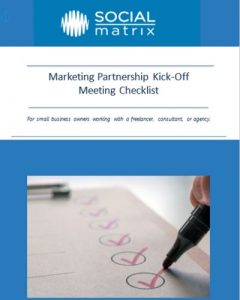You’ve chosen your digital marketing partner and signed the agreement. That’s a big step. Now comes the real challenge: making the marketing partnership work.
This isn’t always straightforward. Many small business owners aren’t sure how much to get involved, what to expect, or how to tell if they’re really getting value for money.
This guide will walk you through the essentials of building a productive marketing partnership. It will show you how to turn a signed contract into a strong, lasting collaboration that delivers results for your business.
Kick Off Your Marketing Partnership the Right Way
The first meeting with your marketing partner sets the direction for everything that follows. This is your chance to agree on what matters, share the right information, and make sure both sides know how to work together.
To make this first meeting easier, we’ve put together a simple Marketing Partnership Kickoff Checklist. It’s completely free to download – no sign-up needed – and will help you cover all the key points with confidence.

Share Access and Information
Your partner can only do good work if they have the tools. Before things begin, make sure they have access to your website logins, hosting details, social media accounts, advertising platforms, and tracking tools such as Google Analytics or Search Console. They will also need your brand assets, including logos, photos, and style guidelines.
If you have already created customer personas, keyword lists, or carried out competitor research, hand those over as well. Even reports from campaigns that failed are useful because they show what has been tried before.
And if some of these resources do not exist yet, do not worry. A reliable partner will guide you through getting organised so that you do not feel left behind.
Define What Success Looks Like
Every business wants growth, but unless you and your marketing partner agree on what that means in practice, you may find yourselves working in different directions. For a café, success might be more people walking through the door each week. For a tradesperson, it could be more phone calls that turn into booked jobs. For an online shop, it might be an increase in sales or a higher conversion rate from visitors to customers.
This is why you need to define clear, measurable goals together. Ask yourself what real progress would look like. Is it twenty extra enquiries a month, a rise in repeat customers, or stronger recognition in your local area?
Once these outcomes are agreed your partner can create a plan designed to reach them and identify the key performance indicators that will track progress. From the start, both sides will know what they are aiming for and how success will be measured.
Talk Budget and Timeline
Budget and timing are often the most sensitive points in a marketing partnership, so it is best to discuss them openly from the beginning.
Be clear about what you can spend and ask your partner to explain what is realistic within that figure. They should outline exactly what is included in the budget, from the number of campaigns to the reporting you will receive, and also make you aware of anything that would count as an extra cost.
Extras are not necessarily a problem if they are talked through in advance. Adding a last-minute campaign or testing a new content format might mean more work and more cost, but if you know this at the start, there will be no unwelcome surprises.
Timelines deserve the same level of clarity. A short advertising campaign can produce results within days, while organic SEO can take months to show steady growth. Talking through this early keeps expectations realistic and prevents frustration when progress follows a slower cycle.
Agree on Communication and Involvement
Communication is the backbone of any strong marketing partnership.
During the first meeting, agree on how often you will check in and how those updates will take place. It could be weekly calls, monthly reports, or another routine that works for both sides. What matters most is consistency, so that everyone always knows when the next update is coming.
Decide as well which channels you will use. Some people prefer the speed of instant messaging, while others are more comfortable with email or project management tools. Choosing your main channels at the start helps avoid confusion later.
Decide early how hands-on you want to be. Some business owners prefer to approve every post, while others only approve the overall strategy. Be clear about your preference so your partner knows how much freedom they have.
Put It in Writing
After you’ve agreed on goals, budgets, and how you’ll work together, the final step is to make it official. A simple contract keeps both sides on the same page and prevents misunderstandings later.
The contract should reflect what you’ve already discussed: what’s included in the work, how much it costs, and when payments are due. It’s also the place to confirm who owns your website, content, and customer data. This is your business, and these should stay with you.
If you’ll be sharing customer details, such as email lists or booking information, ask your partner how they will keep this data safe and private. This doesn’t need to be complicated, but it’s worth checking so you know your business and your customers are protected.
Once everything is written down and signed, you can move forward with confidence, knowing that the basics are agreed and your partnership has a clear foundation.

It’s a Marketing Partnership, Not a Handover
Hiring a marketing partner does not mean stepping back and leaving them to it. The best results come when both sides play their part. Your partner brings marketing expertise. You bring something they can’t: the day-to-day knowledge of your customers and your business.
Share What Only You See
Your partner will not always know what is happening inside your business unless you tell them. A new offer, a stock shortage, or a change in staff might seem small, but it can make a big difference to how campaigns run. The sooner they know, the easier it is to adjust without losing momentum.
You also see customer reactions first-hand. The questions people keep asking, the feedback they give, or the products that are selling faster than expected — these are insights your partner can’t get from analytics alone. Sharing them early can spark ideas and make campaigns far more relevant.
Balance Involvement with Trust
Some business owners take a step back completely and then feel disappointed when results don’t match expectations. Others get involved in every post and slow everything down. Neither approach works well.
It is natural to want to stay involved, especially when you are investing money, but the key is finding the right balance.
The most effective marketing partnerships work in the middle – you share the insights only you can provide, and trust your partner to manage the day-to-day delivery. Once you have agreed on the strategy and the key messages, give them space to get on with the work you hired them to do.
Working Day-to-Day in Your Marketing Partnership
Once your marketing partnership is up and running, the difference between average results and great ones often comes down to how you work together day to day.
Keep Things Open
Partnerships work best when both sides are honest. If you’re facing challenges such as a quieter season, or budget change, share them with your partner. They can then adjust campaigns so time and money aren’t wasted.
Openness should go both ways. Your partner should also feel comfortable saying when results are slower than expected, or when a different approach could work better. Having these conversations on time builds trust and helps you avoid bigger problems later.
Understand Their Process
Every partner has their own way of working. Ask them to explain it clearly. How do they plan campaigns? When do they create content? How do they handle urgent requests?
Understanding their process helps you fit in rather than work against them. For example, if you know they batch content creation at the start of the week, you’ll avoid sending major changes midweek and causing unnecessary delays.
Turn Reviews into Progress
Review meetings can easily become box-ticking exercises. To avoid this, prepare properly. Think about what you want to ask before the meeting. What’s working well? What feels off? What new opportunities have come up in your business?
Focus on trends rather than reacting to every single dip in performance. One quiet week on social media doesn’t mean the strategy has failed. Look at patterns over time to understand the bigger picture.
Reviews should also look forward, not just back. Ask what the data means for next steps. Which campaigns need more attention? Where should the focus shift for the next month? And don’t be afraid to admit when you don’t understand the data. A good partner will explain it in plain language instead of hiding behind jargon.
Don’t Let Approvals Slow Things Down
Nothing slows down a campaign like waiting weeks for approval. Respond promptly to requests for sign-off, even if you need more time to give detailed feedback. A quick reply keeps your partner informed and prevents momentum from stalling.
Give Feedback That Works
Feedback is most helpful when it gives context. Instead of saying “I don’t like this,” explain why. Maybe the tone feels too casual for your audience, or perhaps your priorities have shifted since the plan was agreed. That extra context allows your partner to make meaningful changes.
Try to focus on strategy rather than micromanaging tactics. It’s more useful to say “I’m not sure this message will resonate with our audience” than to reword every headline yourself. Save minor tweaks for your regular check-ins rather than sending constant piecemeal changes.
It’s also worth separating preferences from problems. There’s a difference between “I personally prefer the blue version” and “our customers won’t understand this message.” Make sure your partner knows which type of feedback you’re giving.
Agree How to Handle New Requests
It’s normal to get new ideas once the work has started. You might want to try a different type of content, add another campaign, or respond quickly to an opportunity. That’s part of running a business.
The key is agreeing with your partner on how these requests will be handled. If it wasn’t covered at the start, talk about it now. Decide together what counts as a small change that can be included in the current plan, and what would be seen as new work that may need extra time or budget.
If new ideas come up often, use your regular review meetings to raise them. That way, you can discuss how they fit into the strategy without breaking the flow of ongoing work.
Having clear rules for changes means keeping focus. It makes sure new requests add value instead of pulling energy away from what’s already working.
Know What Progress Looks Like
Marketing rarely delivers instant results. Paid ads might show activity in a few days, but most campaigns take longer. Social media engagement builds over weeks. SEO takes months to show real gains. Awareness campaigns may take even longer.
That doesn’t mean nothing is happening in the meantime. Real progress often shows up first in other ways. You might see more comments, shares, and meaningful interactions before you see sales. You may notice better-quality enquiries, even if the total number is the same. Rising rankings for your key search terms are another early sign that your efforts are working.
Look out for these indicators while giving campaigns the time they need to mature. The difference between slow progress and no progress is easy to miss unless you know what to watch for.
Celebrate the Wins, Learn from the Rest
Strong partnerships celebrate success but also learn from setbacks. When a campaign works better than expected, take time to understand why so you can repeat it. When something doesn’t land, treat it as useful data rather than failure.
Your partner should be open about what didn’t work and why. If they only ever share good news, it may mean you’re not getting the full picture. Honest conversations about both successes and challenges help the partnership grow stronger over time.

Final Thoughts
A successful marketing partnership works when both sides bring out the best in each other. The strongest partnerships are built on clear communication, realistic expectations, and mutual respect, and they often last for years. Over time, your partner gets to know your business almost as well as you do, and that’s when the best results happen.
Challenges will still come up, and that’s normal. What matters is how you deal with them together. With the right partner, open conversations and a willingness to adjust will keep the relationship strong and the results moving forward.
If you’d like more detail on the challenges small businesses often face with agencies, our guide on Problems With Digital Marketing Agencies explains the most common issues and how to fix them.
Looking for a digital marketing partner who understands how to work effectively with small businesses? At Social Matrix, we’ve been working with small business owners and building successful marketing partnerships since 2010. We believe the best results come from genuine collaboration and clear communication.
Contact us today! We’d love to discuss how we can work together to grow your business.

